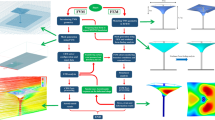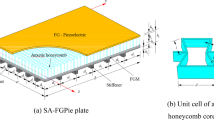Abstract
An experimental investigation was carried out to study the fluid–structure interactions on a compliant panel subjected to an impinging shock wave and an incoming turbulent boundary layer. These experiments were aimed at understanding the time-averaged and unsteady characteristics of fluid–structure interaction at Mach 2. Two shock impingement locations on the panel (aspect ratio of 2.82), namely the central and three-fourths of the panel length, were tested. The shock boundary layer interactions on a rigid flat plate served as a baseline case. Measurements include shadowgraph and surface oil flow visualizations, panel deflections using a capacitance probe, cavity acoustics using a pressure sensor, surface pressures using discrete pressure sensors, and pressure-sensitive paints. Results show that the interaction on the compliant panel is relatively three-dimensional as compared to a rigid plate with a nominally two-dimensional interaction. Pressure fluctuations on the compliant panel are significantly higher than on the rigid plate, and the fluctuation spectra are multi-modal. Strong coupling at some frequencies was observed between the shock and the panel for both shock impingement locations. The present study suggests that for a compliant panel, the shape of pressure spectra is sensitive to the measurement location on the panel, the panel modifies the pressure distribution around the interaction, and the energy in dominant modes depends on the shock impingement location.





















Similar content being viewed by others
Data availability
Data available on request from the authors.
Abbreviations
- a :
-
Panel length (streamwise) (mm)
- b :
-
Panel width (spanwise) (mm)
- d :
-
Cavity depth (mm)
- fPSD\(_\text {u}\) :
-
Freestream pre-multiplied spectra of the wall-pressure fluctuations (kPa\(^2\))
- fPSD:
-
Pre-multiplied spectra of the wall-pressure fluctuations (kPa\(^2\))
- \(f_\textrm{s}\) :
-
Frequencies in the region of shock/boundary layer interaction (\(\textrm{Hz}\))
- h :
-
Panel thickness (mm)
- I :
-
Wind-on image intensity
- \(I_{{ 0}}\) :
-
Reference intensity
- \(L_\textrm{s}\) :
-
Separation length (mm)
- M :
-
Mach number
- \(p_\textrm{amb}\) :
-
Ambient pressure (kPa)
- \(p_{\text {c}}\) :
-
Cavity pressure (kPa)
- \(p_{{\textrm{w}}}\) :
-
Time-averaged surface pressure (kPa)
- \(p_0\) :
-
Reference pressure (kPa)
- \(p_{{\infty }}\) :
-
Upstream static pressure (kPa)
- PSD\(_{\text {probe}}\) :
-
Power-spectral density of the panel displacement (mm\(^2\)/Hz)
- PSD\(_\textrm{PSP}\) :
-
Power-spectral density of pressure fluctuations (mm\(^2\)/Hz)
- Re:
-
Reynolds number per meter
- St:
-
Stroukhal number
- T :
-
Temperature (K)
- \(W_\textrm{s}\) :
-
Width of the intermittent region (mm)
- x :
-
Streamwise coordinate (mm)
- \(x_\textrm{i} \) :
-
Impingement location (mm)
- y :
-
Vertical coordinate (mm)
- \(y^+\) :
-
Non-dimensional distance in the turbulent model
- \(\delta \) :
-
Boundary layer thickness (mm)
References
Dolling, D.S.: Fifty years of shock-wave/boundary-layer interaction research: what next? AIAA J. 39(8), 1872–1873 (2001). https://doi.org/10.2514/2.1476
Touber, E., Sandham, N.D.: Low-order stochastic modelling of low-frequency motions in reflected shockwave/boundary-layer interactions. J. Fluid Mech. 671, 417–465 (2011). https://doi.org/10.1017/S0022112010005811
Liuqing, Y.E., Zhengying, Y.E., Xiochen, W.: Aeroelastic stability analysis of heated flexible panel subjected to an oblique shock. Chin. J. Aeronaut. 31(8), 1650–1666 (2018). https://doi.org/10.1016/j.cja.2018.05.019
Casper, K.M.: Fluid–structure interactions on a slender cone under quiet flow conditions at Mach 6. 58th AIAA/ASCE/AHS/ASC Structures, Structural Dynamics, and Materials Conference, Grapevine, TX, AIAA Paper 2017-0402 (2017). https://doi.org/10.2514/6.2017-0402
Maestrello, L.: Design criterion of panel structure excited by turbulent boundary layer. J. Aircr. 5(4), 321–328 (1968). https://doi.org/10.2514/3.43946
Wilby, J.F.: The response of panels to turbulent boundary layer excitation. Doctoral Thesis, pp. 1–196 (1967)
Frendi, A.: Coupling between a supersonic turbulent boundary layer and a flexible structure. AIAA J. 35(1), 58–66 (1997). https://doi.org/10.2514/2.87
Gordnier, R.E., Visbal, M.R.: Computation of three-dimensional nonlinear panel flutter. J. Aerosp. Eng. 16(4), 155–166 (2001)
Dowell, E.H.: Panel flutter: a review of the aeroelastic stability of plates and shells. AIAA J. 8(3), 385–399 (1970). https://doi.org/10.2514/3.5680
Shinde, V.J., McNamara, J.J., Gaitonde, D.V.: Panel flutter induced by transitional shock wave boundary layer interaction. AIAA Aviation Forum, Atlanta, GA, AIAA Paper 2018-3548 (2018). https://doi.org/10.2514/6.2018-3548
Yen, D.H.Y., Maestrello, L., Padula, S.L.: Response of a panel to a supersonic turbulent boundary layer: studies on a theoretical model. J. Sound Vib. 71(2), 271–282 (1980). https://doi.org/10.1016/0022-460X(80)90351-X
Pretlove, A.J.: Free vibrations of a rectangular panel backed by a closed rectangular cavity. J. Sound Vib. 2(3), 197–209 (1964). https://doi.org/10.1016/0022-460X(65)90108-2
Tripathi, A., Mears, L., Shoele, K., Kumar, R.: Oblique shockwave boundary layer interactions on a compliant panel at Mach 2. AIAA SciTech 2020 Forum, Orlando, FL, AIAA Paper 2020-0568 (2020).https://doi.org/10.2514/6.2020-0568
Tripathi, A., Mears, L., Shoele, K., Kumar, R.: Response of a compliant panel to shock boundary layer interaction at Mach 2. AIAA SciTech 2021 Forum, Virtual Event, AIAA Paper 2021-0489 (2021).https://doi.org/10.2514/6.2021-0489
Sun, C.C., Childs, M.E.: A modified wall wake velocity profile for turbulent compressible boundary layers. J. Aircr. 10(6), 381–383 (1973). https://doi.org/10.2514/3.44376
Musker, A.J.: Explicit expression for the smooth wall velocity distribution in a turbulent boundary layer. AIAA J. 17(6), 655–657 (1979). https://doi.org/10.2514/3.61193
Blevins, R.D.: Formulas for Natural Frequency and Mode Shapes. Van Nostrand Reinhold Co., New York (2009)
Gomez, V., Gramola, M., Bruce, P.J.K.: Oblique shock control with steady compliant panels. AIAA J. 58(2), 1–13 (2020). https://doi.org/10.2514/1.J058933
Varigonda, S.V., Narayanswamy, V.: Fluid structure interactions generated by an oblique shock impinging on a thin elastic panel. J. Fluids Struct. 119, 103890 (2023). https://doi.org/10.1016/j.jfluidstructs.2023.103890
Spottswood, S.M., Eason, T., Beberniss, T.J.: Influence of shock-boundary layer interactions on the dynamic response of a flexible panel. Proceedings of ISMA, pp. 603–616 (2012)
Sun, M., Sandham, M.D., Hu, Z.: Turbulence structures and statistics of a supersonic turbulent boundary layer subjected to concave surface curvature. J. Fluids Mech. 865, 60–99 (2019). https://doi.org/10.1017/jfm.2019.19
Wang, Q.C., Wang, Z.G., Zhao, Y.X.: The impact of streamwise convex curvature on the supersonic turbulent boundary layer. Phys. Fluids 29(11), 116106 (2017). https://doi.org/10.1063/1.4994928
Metheis, J., Hickel, S.: On the transition between regular and irregular shock patterns of shock-wave/boundary layer interactions. J. Fluid Mech. 776, 200–234 (2015). https://doi.org/10.1017/jfm.2015.319
Brouwer, K.R., Gogulapati, A., McNamara, J.J.: Interplay of surface deformation and shock-induced separation in shock/boundary layer interactions. AIAA J. 55(12), 4258–4273 (2017). https://doi.org/10.2514/1.J056030
Adler, M.C., Gaitonde, D.V.: Dynamic linear response of a shock/turbulent-boundary-layer interaction using constrained perturbations. J. Fluids Mech. 840, 291–341 (2018). https://doi.org/10.1017/jfm.2018.70
Adler, M.C., Gaitonde, D.V.: Influence of separation structure on the dynamics of shock/turbulent-boundary-layer interactions. Theor. Comput. Fluid Dyn. 36, 303–326 (2021). https://doi.org/10.1007/s00162-021-00590-y
Acknowledgements
We sincerely acknowledge the funding provided by DARPA under Grant No. D19AP00035, managed by Rohith Chandrasekar. The author would also like to acknowledge the expertise of our machinist, Jeremy Phillips, who is always willing to take up challenging models for machining, and Lee Mears for assisting with a part of the experiments.
Author information
Authors and Affiliations
Corresponding author
Additional information
Communicated by A. Sasoh.
Publisher's Note
Springer Nature remains neutral with regard to jurisdictional claims in published maps and institutional affiliations.
Rights and permissions
Springer Nature or its licensor (e.g. a society or other partner) holds exclusive rights to this article under a publishing agreement with the author(s) or other rightsholder(s); author self-archiving of the accepted manuscript version of this article is solely governed by the terms of such publishing agreement and applicable law.
About this article
Cite this article
Tripathi, A., Gustavsson, J., Shoele, K. et al. Effect of shock impingement location on the fluid–structure interactions over a compliant panel. Shock Waves 34, 1–19 (2024). https://doi.org/10.1007/s00193-024-01162-9
Received:
Revised:
Accepted:
Published:
Issue Date:
DOI: https://doi.org/10.1007/s00193-024-01162-9




